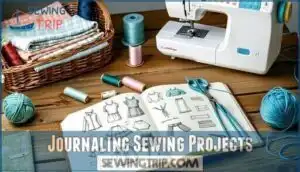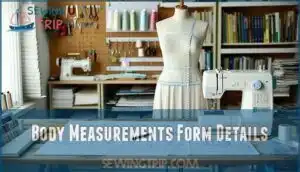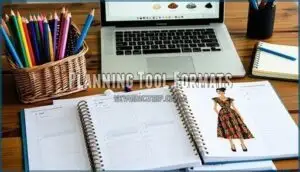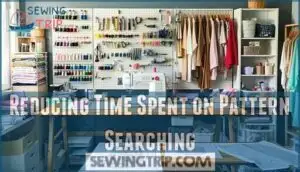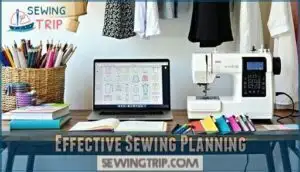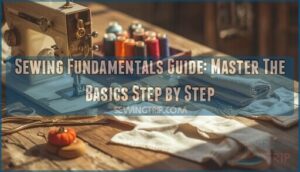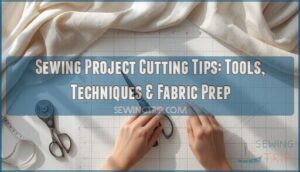This site is supported by our readers. We may earn a commission, at no cost to you, if you purchase through links.
 You’ll transform your chaotic sewing room into a well-oiled machine with the right sewing project planning tools.
You’ll transform your chaotic sewing room into a well-oiled machine with the right sewing project planning tools.
Digital options like Trello and Milanote keep your fabric stash, pattern collection, and project queue organized in one place.
Physical planners offer tactile satisfaction—perfect for sketching designs and tracking measurements, think of these tools as your sewing GPS, preventing those "I bought this fabric for what project?" moments we’ve all experienced.
Whether you prefer apps or paper, effective planning reduces pattern-hunting marathons and keeps your creative momentum flowing.
The secret lies in finding the perfect blend of digital efficiency and hands-on organization that matches your workflow style, ensuring a seamless and organized sewing process with the right tools.
Table Of Contents
- Key Takeaways
- Sewing Project Planning
- Sewing Planner Features
- Top 9 Sewing Tools
- 1. Quilting Project Organization Tool Kit
- 2. Sewing Project Planner Organizer Tool
- 3. Quilters Dream Project Planning Book
- 4. Sewing Gauge Ruler Tool Set
- 5. Sewing Measuring Tool Kit Set
- 6. Sewing Rulers Set for Designers
- 7. Sewing Journal and Planner Book
- 8. Quilting Sewing Table Woodworking Plans
- 9. Sewing Multi Tool Measure Guide
- Planning Tool Formats
- Sewing Project Management
- Effective Sewing Planning
- Frequently Asked Questions (FAQs)
- Conclusion
Key Takeaways
- You’ll transform chaotic fabric piles into organized success by choosing between digital tools like Trello and Milanote for instant access, or physical planners for tactile satisfaction—the key is finding what matches your workflow style.
- You can eliminate "where did I put that pattern?" moments by using project trackers that manage your fabric stash, store measurements, and keep modification notes in one dedicated space.
- You’ll save time and boost productivity by combining digital convenience with hands-on organization—use apps for inventory tracking while keeping physical notebooks for sketching and design ideas.
- You need to start with one planning tool that you’ll actually use consistently, then gradually build your system—the best planner is worthless if it sits unused while your projects remain scattered.
Sewing Project Planning
You’re staring at a pile of fabric, three half-finished projects, and that pattern you swore you’d start last month—sound familiar?
Smart sewing project planning transforms this creative chaos into organized progress, helping you track patterns, manage your fabric stash, and actually finish those beautiful garments you’ve been dreaming about.
Transform your sewing chaos into organized creative bliss—track patterns, manage fabric, and actually finish those dream garments.
Digital Sewing Planning Tools
Breaking free from sewing chaos starts with smart digital tools.
Trello Boards organize your fabric stash like magic, while Milanote Templates create stunning mood boards.
Store patterns in Google Drive for instant access.
Sketch modifications using Procreate Sketch, then track everything with Digital Planners.
Your digital planning process becomes the backbone of successful project planning, transforming scattered ideas into organized masterpieces.
Effective sewing also relies on a good digital sewing planner to keep projects on track, utilizing digital planning to achieve organized masterpieces with a good digital sewing planner.
Physical and Hybrid Planning Tools
You’ll find physical sewing notebooks offer a tactile approach that many sewists prefer over digital solutions.
These 25-page notepads create dedicated space for complex costume design projects and detailed progress tracking.
- Sewing Journals combine project planning with personal reflections and technique notes
- Planning Apps like Cosplanner bridge digital convenience with hands-on organization methods
- Hybrid Tools merge printable planner templates with traditional sewing organization systems
Many sewists rely on sewing journal records to track their projects and improve their skills.
Benefits of Sewing Project Planners
Whether you’re juggling physical notebooks or digital apps, a sewing project planner transforms chaos into control.
You’ll finally master your fabric stash and track every modification without losing your mind.
| Before Planning | With Planner | Result |
|---|---|---|
| Lost patterns everywhere | Organized pattern library | Find anything instantly |
| Forgotten fabric purchases | Fabric inventory control | No duplicate buying |
| Endless project confusion | Clear sewing goal setting | Focused productivity |
| Time wasted searching | Streamlined sewing productivity hacks | More actual sewing |
Sewing Planner Features
Modern sewing planners pack powerful features that transform your chaotic fabric stash and endless pattern wishlist into an organized creative workspace.
Transform your sewing chaos into creative control with smart planning tools that actually work.
You’ll find project trackers, measurement forms, and journaling sections that keep your sewing timeline on track while preventing those "where did I put that pattern modification" moments, making your workspace more creative.
Organization With Sewing Project Trackers
Organization with sewing project trackers transforms your creative chaos into manageable workflow.
You’ll master project tracking by creating dedicated sewing lists for patterns, notions, and deadlines.
Smart fabric management systems help you catalog your stash efficiently, and your sewing project planner becomes your command center, optimizing time and space planning.
These sewing organization tips streamline project management, turning scattered ideas into structured success, with efficient systems in place.
Journaling Sewing Projects
Why settle for scattered sticky notes when you can create thorough sewing diaries that transform your creative chaos into organized success?
Sewing journals capture every stitch of your journey, turning forgotten details into valuable reference material for future projects.
Here’s what your project logs should include:
- Pattern modifications – Document every alteration with sketches and measurements
- Fabric records – Track yardage, care instructions, and supplier details
- Timeline tracking – Note actual vs. estimated completion times
- Lesson learned – Record mistakes and solutions for next time
Body Measurements Form Details
Recording your body measurements isn’t just busywork—it’s your secret weapon for perfect fits.
Your sewing project planner’s body measurements form becomes a goldmine when you’re torn between pattern sizes.
Smart sewists update their measurement chart quarterly, tracking changes that affect fit analysis.
This data helps you nail sizing guides every time, turning guesswork into precision tailoring that actually flatters your unique body proportions.
Accurate measurements require understanding essential body measurements to achieve the best results.
Top 9 Sewing Tools
You’ll find the right combination of physical tools and digital organizers can transform your sewing workflow from chaotic fabric piles to streamlined project success.
These nine essential planning tools help you track measurements, organize patterns, and manage multiple projects without losing your sanity or your favorite seam ripper, which is crucial for achieving success.
1. Quilting Project Organization Tool Kit
Transforming your quilting chaos into streamlined productivity starts with the right organization toolkit.
You’ll need bobbins clamps, spool solutions, and quilt hangers to tame your workspace.
Binder pockets and project bags keep everything for one quilt together – no more hunting for missing pieces.
Tool organizers and caddies make your go-to supplies portable.
The SINGER Quilting Tool Kit includes fabric clips and folding tools that’ll become your best friends.
Store patterns in three-ring binders with sheet protectors for durability and keep your workspace organized with portable supplies.
Best For: Quilters looking for an efficient way to organize materials, tools, and patterns for streamlined project management.
- Keeps quilting materials, tools, and patterns neatly organized.
- Portable solutions make it easy to carry tools for classes or retreats.
- Durable storage options like binders with sheet protectors protect patterns and instructions.
- Initial setup of organizational tools may be time-consuming.
- Limited compatibility with digital-only quilting workflows.
- May require additional purchases to suit specific storage needs.
2. Sewing Project Planner Organizer Tool
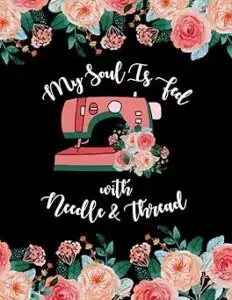
Two files transform your sewing chaos into organized bliss.
The Sewing Project Planner Organizer Tool divides into a logbook and planner, giving you complete project control from start to finish.
You’ll track progress, record measurements, and sketch construction notes in one dedicated space.
This digital organizer includes 12 monthly spreads, 36 weekly project planners with croquis templates, and 30+ pages of expert sewing tips.
It’s your fashion designer’s secret weapon for managing multiple projects without losing your mind or misplacing vital details, making it an essential tool for achieving organized bliss and maintaining complete project control with vital details.
Best For: Sewing enthusiasts, fashion designers, or anyone looking to organize and track multiple sewing projects with ease.
- Limited to those who prefer physical logs over digital alternatives.
- May feel overwhelming for casual or occasional sewing hobbyists.
- Doesn’t include digital storage for patterns or files.
- Includes 12 monthly spreads, 36 weekly planners, and expert sewing tips for comprehensive organization.
- Provides dedicated space for sketches, measurements, and construction notes.
- Helps manage multiple projects while keeping all vital details in one place.
3. Quilters Dream Project Planning Book
Planning quilting projects becomes effortless with the Quilters Dream Project Planning Book.
This 96-page powerhouse lets you track up to 12 projects simultaneously, featuring dedicated four-page spreads for each creation.
You’ll capture construction notes, pattern details, block layouts, and deadlines in one organized space.
The spiral-bound design makes flipping between projects seamless, while tabbed sections offer quick navigation.
At $19.95, it’s an affordable investment that transforms chaotic project juggling into streamlined productivity.
Perfect for quilters who refuse to let another half-finished project gather dust.
Best For: Quilters looking to organize and track multiple projects with detailed planning and goal-setting tools.
- Glossy sheets may make writing difficult for some users.
- Limited to organizing up to 12 projects at a time.
- No included calendar or dated sections for time-specific planning.
- Spiral-bound and tabbed design for easy navigation and durability.
- Includes four-page spreads per project to track notes, layouts, deadlines, and supplies.
- Offers a comprehensive quilting reference section and additional tools for efficiency.
4. Sewing Gauge Ruler Tool Set
Why struggle with inconsistent seam allowances when precision’s just a slide away?
This 5-in-1 T-shaped sliding gauge ruler transforms your measuring game with its double-sided scales and aluminum construction.
You’ll mark buttonholes, hem lines, and seam allowances with surgical precision—no more eyeballing measurements that turn your masterpiece into a hot mess!
The sliding pointer locks in place, letting you repeat identical measurements without breaking stride.
It’s like having a measuring assistant that never gets tired or makes mistakes.
Best For: Beginner and experienced sewists looking for precise, time-saving tools for various sewing and quilting tasks.
- Smaller gauges and pens lack dedicated storage cases for organization.
- Marker pen lids can be easily misplaced during use.
- Compact size may be limited for larger-scale projects.
- Durable aluminum and plastic construction for lightweight and long-lasting use.
- Double-sided scales and sliding pointer enhance accuracy and consistency.
- Multi-purpose functionality suitable for DIY crafts, sewing, and quilting.
5. Sewing Measuring Tool Kit Set
Color-coordinated measuring arsenals revolutionize your sewing precision game.
You’ll eliminate measurement mistakes with these extensive tool kits that include ergonomic tape measures, seam gauges, and specialty rulers.
Each color-coded piece serves specific measuring needs – from body measurements to seam allowances.
These durable acrylic and metal tools won’t let you down mid-project.
Professional seamstresses swear by these complete sets because they’re built to last and enhance accuracy.
You’ll wonder how you ever managed without this organized approach to measuring perfection, achieving measuring perfection with ease.
Best For: Sewing professionals, hobbyists, and home sewers looking to enhance precision and efficiency in their projects.
- Ergonomic, durable design for long-term use.
- Includes specialized tools for various sewing and crafting needs.
- Color-coded pieces make each tool easy to identify and use.
- Some tools may feel flimsy during heavy use.
- Higher price point compared to basic measuring kits.
- Limited color options may not suit all preferences.
6. Sewing Rulers Set for Designers
Beyond basic measuring tools, professional-grade ruler sets reveal your design potential with specialized curves and angles.
The 13-piece French curve ruler collection transforms pattern drafting from guesswork into precision work. You’ll get transparent plastic rulers designed for fashion design, including comma curves, triangular rulers, and multi-function tools.
These metric rulers handle everything from sleeve adjustments to neckline modifications. While some users find them flexible, they’re perfect for beginners learning pattern manipulation.
Think of them as your design training wheels—affordable, extensive, and ready to elevate your sewing game. For accurate cuts, consider using best sewing rulers to enhance your overall sewing experience.
Best For: Beginners, tailors, and designers seeking an affordable and comprehensive set for pattern drafting and sewing projects.
- Flexible plastic may feel too thin for some users.
- Hard-to-read prints on the rulers can make measuring difficult.
- Not ideal for heavy-duty or professional use.
- Wide variety of ruler types for versatile sewing needs.
- Transparent and lightweight materials for easy handling.
- Metric measurements ideal for precise pattern adjustments.
7. Sewing Journal and Planner Book
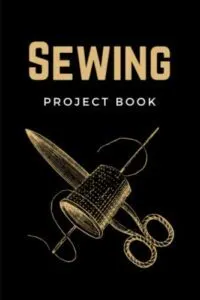
With project details scattered across scraps of paper, you’ll love having everything in one dedicated space.
This 108-page sewing journal features structured sections for project names, patterns, measurements, sketches, materials, and costs.
The 6×9 inch format fits perfectly in your sewing bag, while the premium matte cover withstands daily use.
You can track progress from start to finish, rate completed projects, and document lessons learned, making it like having a personal sewing coach that remembers every detail.
It’s a tool that makes repeat patterns and skill development much smoother.
Best For: Sewing enthusiasts, from beginners to professionals, who want an organized and creative way to document and plan their projects.
- Compact and portable design fits easily into sewing bags.
- Detailed sections to track every aspect of a project.
- Durable premium matte cover ensures long-lasting use.
- Limited to 108 pages, which may fill up quickly for frequent users.
- May not suit those who prefer digital project tracking.
- Requires additional tools for fabric swatching or larger sketches.
8. Quilting Sewing Table Woodworking Plans
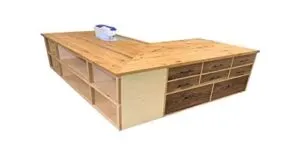
Building your own quilting table transforms your sewing space from cramped chaos into organized bliss.
Ben Stone’s woodworking plans deliver precise AutoCAD blueprints for constructing a 30" deep, 72" long quilting desk that’ll handle your biggest projects.
You’ll get hard copies mailed directly, plus email support when you hit construction snags.
These aren’t just plans—they’re your ticket to crafting furniture that actually fits your workflow.
With over 30 years of engineering experience behind each design, you’re building something that’ll last decades.
This ensures that your quilting table will be a long-lasting addition to your sewing space, providing you with a comfortable and efficient work area for your projects.
Best For: DIY enthusiasts and sewing hobbyists looking to create a durable, custom quilting desk tailored to their workspace needs.
- Requires some woodworking tools and prior experience.
- Plans are only available in hard copy, not digitally.
- Larger table dimensions may not suit small spaces.
- Precise AutoCAD blueprints designed for accuracy and longevity.
- Hard copies shipped directly with ongoing email support.
- Beginner-friendly plans suitable for individuals with basic DIY skills.
9. Sewing Multi Tool Measure Guide
When precision meets convenience, you’ll discover the game-changing power of multi-tool measuring guides.
These compact bamboo wonders pack seam gauges, needle position guides, and hem markers into one streamlined tool.
You can measure seam allowances, mark pleats, and even press hems directly on the heat-resistant surface.
With both metric and imperial measurements at your fingertips, international patterns become less intimidating, making it like having a Swiss Army knife for sewists – one tool replacing five cluttered measuring gadgets on your workspace, which is a truly game-changing experience.
Best For: Beginner and advanced sewists looking for a versatile, eco-friendly tool that simplifies sewing and pattern drafting tasks.
- Combines multiple sewing tools into one compact, portable design.
- Features both metric and imperial measurements for versatility.
- Eco-friendly bamboo construction is durable and heat-resistant.
- Small cutout markings may be challenging to read for some users.
- Limited size may not be ideal for larger sewing projects.
- Minor printing error on measurement markings, though easy to recognize.
Planning Tool Formats
You’ll find sewing planners come in three main formats that match different planning styles and preferences.
Digital PDFs offer instant downloads and hot-linked navigation, printable versions let you customize paper sizes from letter to A5.
Specialized tools include custom croquis integration for fashion sketching.
Digital PDF Planners
Digital PDF planners revolutionize sewing project organization with hyperlinked navigation and customizable templates.
These digital tools offer superior file management compared to traditional methods, letting you track projects across devices.
Modern PDF planner designs include dedicated sections for fabric inventory, pattern modifications, and timeline tracking.
You’ll appreciate the flexibility—print when needed or keep everything digital for seamless sewing planning. Utilizing a sewing pdf planner can greatly enhance your sewing experience.
Printable Planners
Nothing beats the tactile satisfaction of flipping through actual paper planners while organizing your sewing queue.
Printable planners offer incredible flexibility—you’ll customize planner pages, choose print formats, and select binding options that match your workflow.
These PDF planner downloads let you print sewing templates on-demand, creating a personalized sewing project planner that evolves with your creative needs.
Custom Croquis Integration
While printable planners offer flexibility, custom croquis integration takes your sewing project planning to the next level.
You can create personalized figure drawing templates that match your exact body proportions.
These custom sketch templates transform fashion illustration from generic to specific, helping you visualize how digital patterns and pattern flats will actually look on your unique silhouette, which is made possible by custom integration.
Sewing Project Management
You’ll transform your sewing workflow when you manage projects systematically instead of scrambling through pattern boxes and fabric bins.
Effective project management helps you track your sewing queue, monitor fabric inventory, and reduce the time spent hunting for modifications and alterations.
Reducing Time Spent on Pattern Searching
Looking for that perfect pattern shouldn’t feel like hunting for a needle in a haystack.
Smart sewists use Pattern Optimization techniques with Search Filters to slash hunting time by half.
Your sewing project planner becomes a Digital Libraries powerhouse when you tag patterns by difficulty, fabric type, and season.
Pattern Management systems with proper sewing patterns organization transform Time Management, boosting Sewing Efficiency through strategic pattern searching workflows.
Tracking Current and Future Projects
Effective sewing project management transforms chaos into creativity.
Your sewing project planner becomes mission control for tracking every WIP and future dream project.
Essential project tracking features include:
- Project Scheduling with realistic deadlines and milestones
- Progress Tracking through photos and completion percentages
- Task Management breaking complex projects into manageable steps
- Goal Setting for seasonal wardrobe planning and skill development
Smart sewing workflow organization prevents project pile-up nightmares.
Utilizing a sewing project planner with sewing planning tools helps to streamline the entire process.
Effective Sewing Planning
You’ll create the perfect sewing workflow when you combine digital apps with physical notebooks and design templates.
This hybrid approach gives you the flexibility to sketch pattern modifications on paper while tracking your fabric stash and project timelines digitally, allowing for a flexible approach to managing your sewing projects.
Combining Digital and Physical Tools
Smart sewers master hybrid planning by pairing digital notebooks with physical sketching.
You’ll streamline sewing workflows through strategic tool integration, creating a mixed media approach that maximizes efficiency.
Your sewing project planner becomes powerful when digital convenience meets tactile creativity.
| Digital Tools | Physical Tools |
|---|---|
| Trello for project tracking | Paper sketches for design ideas |
| Pinterest for inspiration boards | Fabric swatches and samples |
| Google Drive for pattern storage | Measuring tapes and rulers |
| Procreate for design modifications | Physical notebooks for notes |
| Digital planner organization | Printed reference materials |
Design Templates for Project Ideas
Design templates transform scattered sewing project ideas into organized visual plans.
Your sewing project planner becomes a creative playground when you incorporate structured templates for project sketching and pattern making.
Utilizing free sewing patterns can help beginners create unique and personalized items.
- Idea Boards: Create visual collections of fabric swatches, color palettes, and sewing project inspiration
- Design Layouts: Map garment construction details with technical sketches and measurements
- Creative Planning: Organize project timelines alongside design elements for seamless execution
Frequently Asked Questions (FAQs)
How to plan your sewing projects?
Start by sketching your design ideas and measuring yourself accurately.
Create a timeline with deadlines, gather all materials beforehand, and use digital tools like Trello or Pinterest to organize patterns, fabric inventory, and project queues efficiently.
What is a sewing planner?
Back when seamstresses kept ledgers by candlelight, they tracked every detail.
You’ll use a sewing planner to organize patterns, fabric inventory, measurements, and project timelines.
It’s your roadmap for turning creative chaos into finished garments.
What is the Threadloop app?
I couldn’t find specific information about a Threadloop app in current resources. You might be thinking of another sewing app like Cosplanner, which tracks costume projects and timelines effectively.
What should be my first sewing project?
Practice makes perfect—start with something simple yet satisfying.
You’ll want to tackle a tote bag, pillowcase, or scrunchie first.
These beginner-friendly projects teach essential skills without overwhelming complexity, building your confidence beautifully, and are a great way to learn through practice.
How to budget effectively for sewing projects?
Track fabric costs, notions, and pattern prices before starting.
You’ll save money by shopping sales, using coupons, and buying quality basics first.
Set realistic budgets per project to avoid overspending on impulse purchases.
What supplies are essential for beginners?
Sure, you’ll need another specialized gadget!
Start with basic measuring tape, fabric scissors, seam ripper, pins, hand-sewing needles, and a simple sewing machine.
Don’t forget thread, marking tools, and an iron for crisp results, and make sure to have all these tools to ensure you have a complete set.
How to prevent fabric shrinkage before cutting?
Prewash your fabric using the same temperature and cycle you’ll use for the finished garment. Steam press while slightly damp, then let it completely dry before cutting your pattern pieces.
When should you prewash different fabric types?
Cotton demands hot water while delicate silks whisper for cold—you’ll prewash sturdy cottons, linens, and rayons before cutting.
But save silks, wools, and synthetics for gentle post-construction cleaning to avoid irreversible damage.
How to store finished garments properly?
Hang garments on padded hangers to prevent shoulder dents.
Store knits folded flat with tissue paper between layers.
Use breathable garment bags for delicate fabrics.
Keep everything in cool, dry spaces away from direct sunlight.
Conclusion
Transform your sewing space, organize your projects, and streamline your creative workflow with these powerful sewing project planning tools.
Whether you choose digital apps for instant access or physical planners for hands-on tracking, consistency matters most.
Start with one tool that matches your style, then gradually build your planning system.
You’ll spend less time searching and more time creating, and remember, the best planner is the one you’ll actually use—so pick your favorite and start planning your next masterpiece today.
- https://soniaestepdesigns.com/products/digital-sewing-planner?srsltid=AfmBOoqUR0ilz_CLIBlGnMLlOf6P62ndd7GWGJPMBy16ENau-U7Yvtxh
- https://www.seamwork.com/style-and-wardrobe/the-5-best-digital-tools-for-planning-your-sewing?srsltid=AfmBOopG0Xo6TEG9JAOWH-yxO-5QWbMYDtCXfoYw52X33RAc0MSbTfov
- https://indiestitch.myshopify.com/products/sewing-project-planning-notepad
- https://www.amazon.com/sewing-planner/s?k=sewing+planner
- https://thefloramodiste.com/blogs/tfm/how-to-use-a-sewing-project-planner

